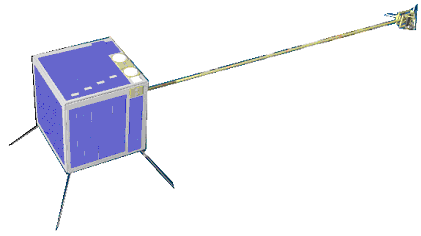MOU Conclusion between NASDA and Australia's CSIRO
on the Launch and Utilization of FedSat
National Space Development Agency of Japan
The National Space Development Agency of Japan (NASDA) concluded with the Australian Commonwealth Industrial & Scientific Research Organization (CISRO) in behalf of the Cooperative Research Center for Satellite Systems (CRCSS) the Memorandum of Understanding (MOU) on the Launch and Utilization of Australia's small satellite, FedSat as follows:
| 1. Concluding Date : | September 19, 2002 |
| 2. Venue : | NASDA Headquarters |
| 3. Signatory : | Mr. Shuichiro Yamanouchi (NASDA President) Dr. Geoff Garrett (CSIRO Chief Executive) |
FedSat is a 50kg piggy-back satellite, which will be launched together with the Advanced Earth Observing Satellite II (ADEOS-II) by utilizing the extra launch capability of the H-IIA Launch Vehicle No 4 (H-IIA/F4).
This is no-money exchange international cooperative mission, and NASDA will receive data from the on-board magnetic field observation device in return for launching FedSat.
NASDA will try to combine the above magnetic field observation data with similar data of the Mission Demonstration test Satellite-1 (MDS-1) and other satellites, and will expect to establish a three-dimensional and comprehensive space environment model in the Earth orbit. The space environment model will be used as basic data for designing a satellite. In this context, FedSat's magnetic field observation data will be expected to contribute to more sophistication of such model.
Australia plans to verify its own space technology through magnetic observation and communications experiments using FedSat.
|
|
Features of FedSat
| Purpose | Verification of Australian Indigenous Space Technology | |
|---|---|---|
| Mission | Magnetic Field Observation Experiment Experiments Using Ka/UHF Bands Communications Devices GPS Experiment High Performance Computing Experiment Carrying CD-ROM Containing the Audio Messages to Commemorate the 100th Anniversary of the Federation. |
|
| Dimension | Main Body | Approx. 50 cm Cube |
| Deployable Antenna Mast | 2.5m | |
| Weight | About 58kg | |
| Orbit | Circular Orbit at an Attitude of about 800 km with Orbital Inclination of about 99 Degrees | |
| Attitude Control | 3-Axis Stabilized | |
| Frequency | S Band | |
| Life | 3 years (target) | |
| Executing Agency | Cooperative Research Center for Satellite Systems, Australia (CRCSS) | |
Overview of FedSat
